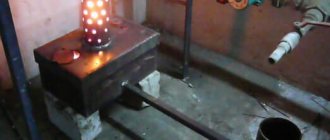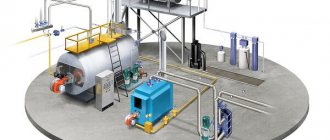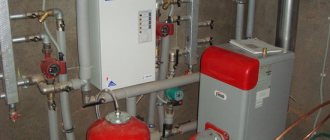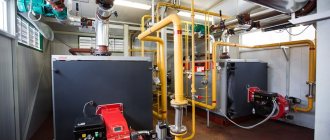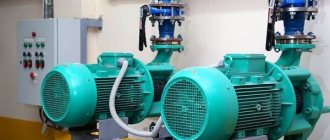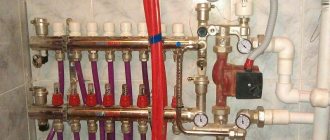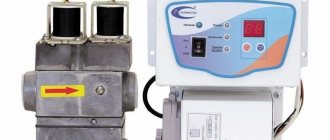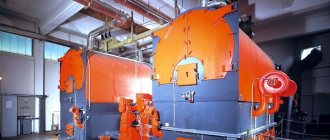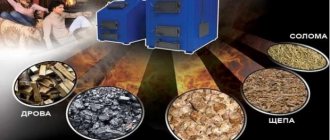Description of the fuel oil boiler room
An oil boiler house is a well-organized heating installation equipped with high-quality equipment. The popularity of such complexes is explained, first of all, by the fairly low price of fuel.
The operating principle of an oil-fired boiler room is to use this type of fuel to heat the coolant to the required parameters. The proposed installations can be used as emergency or backup systems in the event of a failure in the operation of systems with the main type of fuel (for example, gas).
Fuel oil boiler houses (SPb) include fuel oil facilities. If this type of fuel is “spare”, then one tank is provided for its storage. If fuel oil is the main fuel, two containers are used. The amount of substance is designed for autonomous operation of the system for a certain time.
Oil-fired boiler installations (systems) operate on high-calorie fuel material. The most acceptable option for high-quality operation of the complex is the F 40 brand, but, as practice shows, the M 40, M 100 and M 200 brands are most often used.
Boiler houses using fuel oil in Russia (St. Petersburg) are offered by many companies. But it’s worth spending time and finding the most worthy one, since the correct design and competent assembly are the key to the future successful operation of the complex.
Topic 10. Preparation of liquid fuel for combustion.
Schematic diagram of the fuel oil economy of the boiler room. Preparation of fuel oil for combustion (heating temperature, use of additives).
Schematic diagram of the fuel oil economy of the boiler room.
When operating boiler plants, fuel oil is used as: the main and only type of fuel; reserve and emergency fuel, when the main fuel is gas; kindling fuel, when the main one is solid fuel burned in pulverized form.
Fuel oil is usually delivered by rail in tanks. Fuel oil is supplied to installations located a short distance from oil refineries through pipelines.
Fuel oil facilities for the delivery of fuel oil by rail consist of the following structures and devices: a drain rack and an intermediate tank; fuel oil pumping station with pumps for pumping fuel oil; fuel oil storage facilities with reinforced concrete or metal tanks; fuel oil pipeline systems between fuel oil tanks, fuel oil pumping and boiler plants; devices for heating fuel oil and wastewater treatment; installations for receiving, storing and introducing liquid additives into fuel oil; fire extinguishing systems.
The diagram of the fuel oil facility is shown in Fig. 10.1. From the railway tanks located on the overpass during the draining period, fuel oil flows through a portable drain tray into the drain chute and then through the outlet pipe into the receiving tank. From it, fuel oil is pumped into fuel oil storage tanks (as a rule, at least two tanks are installed). From it, as necessary, through coarse and fine filters and heaters, fuel oil is supplied by pumps to the burners of boiler units. Part of the heated fuel oil is sent through the recirculation line to the fuel oil storage facility to heat the fuel oil located there. To avoid freezing in the pipes, fuel oil continuously circulates in them - after passing along the boiler room, it returns to the fuel oil storage site. Steam lines are laid together with fuel oil lines and provided with general insulation.
Rice. 10.1. Fuel oil preparation scheme: 1 - tank; 2 — channel (tray); 3 — receiving tank; 4 - transfer pump from the receiving tank; 5 - main tank; 6, 10 — coarse and fine filters; 7, 11 — pumps of stages I and II; 8 — fuel oil heater; 9 – fuel oil pumping pump recirculation line; 12 - emergency valves; 13 — fuel oil pressure regulator; 14 - fuel oil consumption; 15 — boiler nozzles; 16 - recirculation fuel oil pipeline from the boiler room to the fuel oil pumping station
Fuel oil filters are designed for coarse and fine cleaning (the number of holes on the mesh is 5 or 40 per 1 cm2) of fuel oil from solid residues of oil fractions and mechanical impurities.
Preparing fuel oil for combustion.
To reduce the amount of bottom sediments during long-term storage, reduce the amount of soot formed during combustion and reduce contamination of the boiler heating surfaces, liquid organic or water-soluble mineral additives (0.5 - 2 kg/t), for example, the VNIINP series [8], are added to the fuel oil.
Heating of fuel oil is necessary to ensure its fine atomization under conditions of combustion intensification. M40 grade fuel oil should be heated to a temperature of 80 - 100 °C, M100 grade - 100 - 120 °C, M200 grade (the most highly paraffinic) - not lower than 135 °C.
To heat drain trays and heat fuel oil in receiving and main tanks to 70 °C, steam with a pressure of 0.6 - 1.2 MPa or hot water with a temperature of up to 150 °C is usually used.
Advantages of an oil boiler house
The obvious advantages (advantages) of a block-modular fuel oil boiler house distinguish it favorably from analogues (for example, solid fuel):
- Factory readiness. High-quality assembly in production conditions.
- Automation. In automated fuel oil boiler houses, equipment is optimally selected and distributed, and all sensors and systems operate without the help of technical personnel.
- Economical. No capital construction costs, no permanent operator presence and low fuel costs.
- Safety. Minimal risk of fire.
It is also worth noting the minimum production time for a fuel oil boiler room - you can always find out more about this from specialists.
Benefits from using an oil boiler
It is believed that an oil-fired boiler is superior in efficiency to any solid or liquid fuel. The disadvantages include the maintenance of a fuel oil facility. In many respects it can compete with gas ones, differing in the following advantages:
- Oil, diesel, and gas are steadily becoming more expensive. Fuel oil is a waste product from the refining of petroleum products. It has a more favorable price;
- Fuel oil is considered fireproof;
- It has high efficiency;
- Coordinating and approving design documentation for fuel oil boiler houses is much easier than for gas boilers;
- Possibility of autonomous operation away from gas pipelines and populated areas;
- Factory assembly ensures high availability;
- The standard equipment provides for automatic operation of the boiler room, without the participation of operators and personnel.
The advantages of natural gas are undeniable. But when heating boilers are selected far from gas mains, fuel oil remains the most promising and profitable type of fuel.
Complete set of fuel oil boiler room
Since these complexes are liquid fuel, the production of an oil boiler depends on various factors:
- Required power.
- Fuel oil stock quantities.
- Options for fuel delivery and storage.
High-quality construction of fuel oil boiler houses is based on accurate calculations and careful selection of appropriate equipment:
- Building.
- Boilers.
- Pump group.
- Expansion membrane tank.
- Fuel supply, unloading and storage system.
- Fuel purification filters.
- Chimney.
- Control system.
- Alarm and other components.
After weighing all the pros and cons, many customers choose fuel oil boiler houses, the price of which varies within reasonable limits. The cost of the system largely depends on the required power and size.
When creating a project for a boiler house using fuel oil, a diagram, drawing, technological map and other calculations are required. Employees are always ready to: correctly calculate the required amount of fuel, the total power of the installation, take into account the availability and need to order the appropriate components, calculate the total amount of investment, etc.
It is best to find out the cost and buy an oil boiler from a specialized company that has:
- Considerable experience in this field.
- All permits.
- Lots of good reviews from established clients.
Scope of application of serial PM
Fuel oils play an important role in the fuel and energy balance of the Russian Federation. More than 30% of produced Russian oil during its refining is converted into heating oil, the main consumers of which are thermal power plants and boiler houses. To increase the operating efficiency of boiler units, it is necessary to reduce the viscosity of fuel oil to a value that gives it a more fluid working consistency before feeding it into the burner nozzles of liquid fuel boilers. This ensures high-quality atomization of fuel oil during its combustion and ensures its complete combustion. Heating of fuel oil in order to liquefy it is carried out by special heaters that use the thermal energy of steam, hot water, hot oil, and electricity. In industrial heat supply power plants, PM series heaters are used with a steam coolant that heats the fuel oil before feeding it to the burner in the temperature range of 95-125 degrees C.
Types of steam boilers
PCs are classified according to several parameters and you need to know them, because how the steam boiler works depends on it.
By type of fuel burned:
- gaseous fuel;
- solid fuel steam boilers;
- liquid fuels: fuel oil, diesel fuel;
- Electric Energy.
By purpose:
- Waste heat boiler - participates in schemes for saving fuel and processing secondary heat emitted during the production process or from flue gases at thermal power plants.
- Energy - steam boiler houses are involved in the electricity generation scheme as a source of steam for turbines; they operate with high flow rates and steam parameters.
- Heating units for central heating and hot water supply, which are subject to the rules for the design and safe operation of steam and hot water boilers.
- Industrial - participate in the production processes of the enterprise.
Classification of steam boilers by firebox design:
- Chamber - use pulverized fuel.
- Bed solid fuel – burning solid fuel.
Water tube
The operation of water tube boilers (WTB) is characterized by the fact that the main coolant - feed water - passes through the screens, and flue gases through the inter-tube space. Reaching the boiling point, water turns into steam.
The efficiency of steam generation depends on the design of the screen pipes and the type of feedwater circulation; these indicators are taken into account before calculating the power. The most used VK schemes are drum and direct-flow. The first type of steam boiler is designed horizontally or vertically.
A typical drum boiler design is a firebox limited by pipe screens, the packages of which are connected at the bottom by manifolds, and the top is fixed in the upper drum. The second bundle of boiler pipes connects both VK drums into one circuit operating in a zone of lower temperatures.
The heat from fuel combustion is transferred through the pipe system to water by convection and radiation; the steam-water mixture enters the upper drum, where steam is separated from moisture.
Released water into the lower drum and combustion headers. The circulation speed of the internal circuit of the VC depends on its type. The most popular boilers on the Russian market are those with natural circulation.
The production of steam boilers is carried out at the Biysk Boiler Plant: DKVR-2.5; 4; 6.5; 10; 20.
Fire tube
Gas-tube or fire-tube boilers are VK “in reverse”, that is, water moves through the inter-tube space, and the exhaust gases are in one or more pipes. These low power steam boilers remain in use from the pre-war period of the 19th century.
Steam production process:
- The firebox is located directly in the tube part of the boiler, where combustion of the fuel mixture occurs and the formation of flue gases.
- These devices are manufactured with flame or smoke tubes.
- In the first, the combustion process occurs directly in the pipe, for which a gas-oil burner with a fan is installed at the inlet, promoting uniform combustion along the length of the firebox.
- In smoke stacks, fuel is not directly burned, but water is heated by heated flue gases.
For these boilers with a steam pressure below 0.7 MPa, the rules for the design and safe operation of steam and hot water boilers do not apply. Boiler water moves through the inter-tube space and, when heated, turns into steam; the process is completed in the upper part of the boiler and, with the help of a bypass valve, the steam passes into the main line.
Diesel boilers have a limit on the outlet temperature of flue gases of up to 150 C. This requirement is caused by the need to technologically ensure draft in chimneys. This fact reduces the power of boilers - about 400 kW, with steam pressure up to 10 kgf/cm2.
Cast iron sectional
Boilers with cast iron packages or sections are widely used in heating and hot water networks. The design of such units has advantages due to the possibility of quick assembly or dismantling, as well as a simple increase in boiler power by adding sections.
The operation of steam boilers with a successful design has a significant drawback: if one package breaks, all sections of the unit will have to be dismantled.
Boiler owners do not require permits, since they are not subject to the rules for the design and safe operation of steam and hot water boilers.
These boilers are efficient and heat up quickly, since the combustion chamber is formed directly by the internal surfaces of the sections.
The units resist corrosion processes well in the aggressive environment of flue gases and have increased thermal conductivity, but are not capable of operating at high steam parameters, maximum pressure values are less than 100 kPa, power values are not more than 200 kW, steam output is up to 4.3 t/hour, consumption solid fuel - 300 kg/hour.
Direct flow
Direct-flow steam units belong to vertical steam boilers and are designed so that the water in the screen pipes is forced to complete only one cycle and at the same time completely transform into a vapor state, therefore, in these types of steam generators, the circulation ratio is 1.
Such boilers are much simpler in design and do not require complex automation of the combustion process. They are non-volatile and cannot do without a feed pump, therefore they are much more explosive than circulation boilers, despite the fact that their thermal efficiency and steam production are low.
Once-through installation
In a once-through unit, the movement of water occurs due to gravitational convection, since water is heavier than steam. Recently, for devices that have reached their standard service life, steam boilers have been switched to hot water mode to reduce the load.
Features of a single-turn PC:
- The firebox is made of pipes that are heated by flue gases.
- Boiler water enters the lower part of the water heating circuit, and dry steam is taken from the opposite upper part.
- In the economizer, the incoming coolant is heated to saturation temperature, and in the screen pipes and superheating circuit, the steam parameters further increase to the design values.
- These surfaces do not have a clear separation from each other, and their geometry depends on the design load of the unit. With a decrease in the temperature of the flue gases and an increase in the speed of the boiler water, the boundaries of the economizer and evaporator shift, and the length increases accordingly and vice versa.
- Steam production is limited by the increase in hydraulic resistance and cannot be more than 10 t/h. For more powerful boilers, multi-turn unit designs are required.
Steam BMK
Block-modular boiler house (BMK) manufactured in the form of a compact module with a full set of auxiliary equipment.
It is intended for heating and hot water supply, as well as generating steam for the technological needs of enterprises located in areas with energy shortages. The BMK does not require the constant participation of an operational person, and in the event of an emergency, protection with an alarm is triggered.
The operation of the unit is fully automated: sensors monitor the internal temperature of the room, the data is transmitted to the control panel, where the operation of the BMK is adjusted.
The unit can be quickly connected to an existing heating system as an independent emergency source of thermal energy.
Transportation to the installation site of the BMK is carried out in full factory readiness and with a chimney; on site it is only connected to existing utility networks. This factory assembly minimizes installation and adjustment work and increases the efficiency of the installation to 93%.
